Ticha
May Helena Plumb
Welcome! This module is a guided tour of Ticha (https://ticha.haverford.edu). You do not need any previous experience with Zapotec language or colonial documents — all you need is access to the Ticha website and some curiosity about Colonial Zapotec! This chapter is a good place for both students and instructors to learn some basic information about Ticha and Colonial Zapotec before working through the other modules in Caseidyneën Saën.
After exploring Ticha, you can learn more about archival sources with the module on Colonial Documents and Archives or jump straight into Colonial Valley Zapotec with the module on Numbers.
Resources in this module: Teaching Summary · Answer Key · Spanish Version
1. Zapotec languages and colonial writing
Zapotec languages (there are many!) belong to the Otomanguean stock and are indigenous to what is now Oaxaca, Mexico. There are probably over 400,000 speakers of Zapotec languages today, and many Zapotec speakers are actively resisting linguistic and cultural threats from deeply embedded discriminatory beliefs and behaviors that deny and devalorize the Zapotec language, people, and knowledge.
Zapotec languages have been spoken in Oaxaca for thousands of years, and there are examples of Zapotec writing as early as 500 B.C.E. Early Zapotec writing used a mostly system, but starting in the late 16th century, people began writing Zapotec languages using the Latin alphabet (the same system used to write English and Spanish). Zapotec people wrote their wills, receipts, and other legal documents in their own language, and Spanish priests printed Zapotec translations of Catholic doctrines. Many of these colonial documents still exist today, preserved in archives throughout the world. By reading these documents, we can learn about the history of Zapotec people and their languages.
2. The Ticha Project
Even though there are hundreds of Colonial Zapotec documents, it can be very hard to find them. Many Zapotec documents are stored in archives in Mexico City or even the United States, far away from where they were originally written. Sometimes the does not mention in which language these documents were written in, so it is hard to locate texts written in Zapotec in the archive catalog. Moreover, reading a Colonial Zapotec document can be very difficult, even if you speak a modern Zapotec language — the handwriting might be hard to decipher, and the languages have changed significantly in the past 500 years.
For example, the images below in Figure 1 come from the Colonial Zapotec will of Rafael Luis, written in San Pedro el Alto in 1684 (https://ticha.haverford.edu/en/texts/Al684/).

Exercise 2.1
Did trying to transcribe the first line in the San Pedro el Alto document in Figure 1 get you excited to try and transcribe more? Did you recognize some words? Do you wonder what the whole line means, or maybe even what the whole document means? Learning to read and translate a Colonial Valley Zapotec document will take time — but it is something that you can learn to do!
Exercise 2.2 (Optional)
Are you wondering what these Colonial Zapotec words mean or how to pronounce them? In this short video, Dr. Brook Danielle Lillehaugen describes Ticha’s Vocabulary page. This page includes short definitions, and you can also hear how some words are pronounced in Zapotec languages spoken today! (The video is in Spanish; you can turn on English subtitles by clicking CC in the bottom right.)
(To get to the vocabulary page, click on Colonial Zapotec Language in the navigation bar, then click on Vocabulary; or, go to https://ticha.haverford.edu/en/vocabulary/A/.)
3. Explore a manuscript
The Ticha Project was founded to increase access to Colonial Zapotec documents, since not everyone has access to the archives where the original documents are stored. Using the Ticha website, you can browse images of the documents, as well as transcriptions, translations, and further context for some documents. If you want to see the documents in person, Ticha provides reference numbers to look up each document in an archive. You can also learn a lot about the document from what is available on Ticha. Let’s take Rafael Luis’s will as an example. Use this link to see the document on Ticha.
On Ticha, each page has two parts: the photographs of the document are on the left, and information about the document is on the right (see Figure 2). Rafael Luis’s will has three pages: you can click the smaller images on the bottom of the screen to see each page. Within an image, you can zoom in and scroll using your mouse or the white icons at the top.
The information on the right of the page is called . This includes information about what kind of document it is, where and when the document was written, and what people are mentioned in the text.
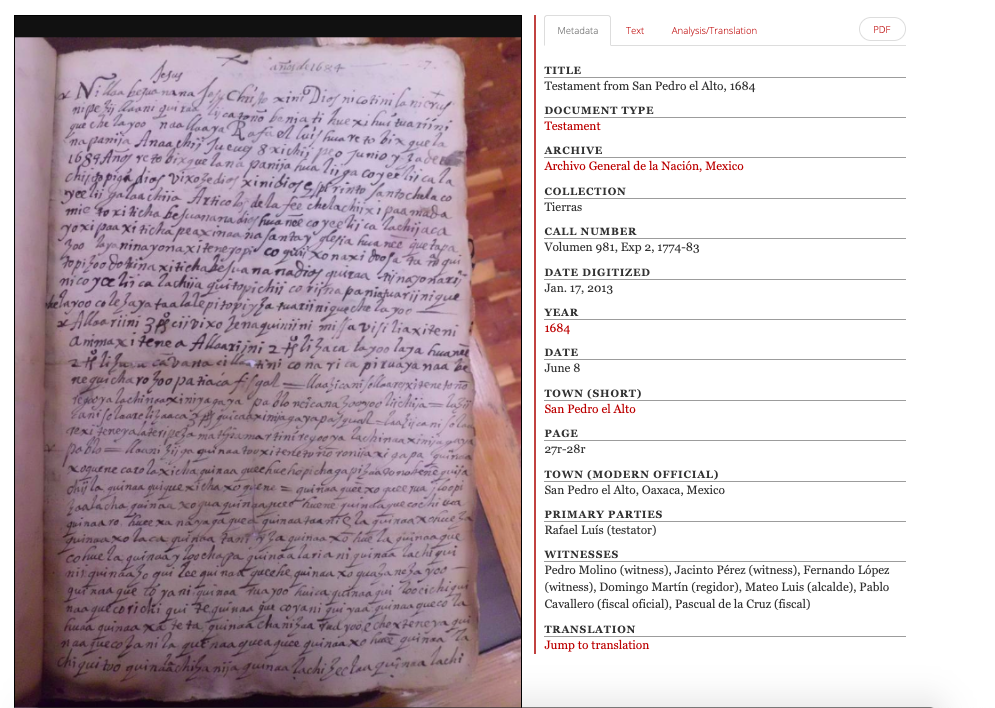
Exercise 3.1
The metadata also includes information about the archive where the document is currently stored. Archives are similar to libraries: you can imagine a room filled with books. Books are organized on different shelves depending on the topic and time period. We call each shelf a “collection”. To help you find a specific book, each collection has a name and each book is labeled with a call number to help you find it on the shelf. Since many different documents may be gathered together in a single book, it’s also important to note the page number.
Exercise 3.2
Above the metadata, there are several other tabs that show different information about the document. If you click on the Text tab, the metadata will be replaced by the transcription of the document that we have on file (see Figure 3).

Exercise 3.3
If you find a document that hasn’t been transcribed yet, you can contribute a transcription by clicking on the Transcribe tab. You can also download a copy of the document, and its transcription, by clicking the PDF tab. This will let you look at the document even if you don’t have an internet connection.
Exercise 3.4 How does it work in your language?
Sometimes Colonial Zapotec documents were later translated into Spanish. At the bottom of the metadata for Rafael Luis’s will, there’s a link that says “Jump to translation” which will take you to images of the Colonial Spanish translation on Ticha.
4. Find other documents
There are over 200 documents on Ticha. That’s a lot to look through individually! Let’s learn some ways to identify which documents you might be interested in.
Using the red navigation bar at the top of the website, click on Explore.

In this tab, you can choose to explore available manuscripts in several ways, including by the time they were written and by the town they were written in.
First, click on Time. Ticha has documents from the 1600s up through the early 1800s. If you’re curious about documents from a specific time period, you can use this timeline. Clicking on a document in the timeline will bring up a short description of the document and a link to where you can see the full image and metadata.
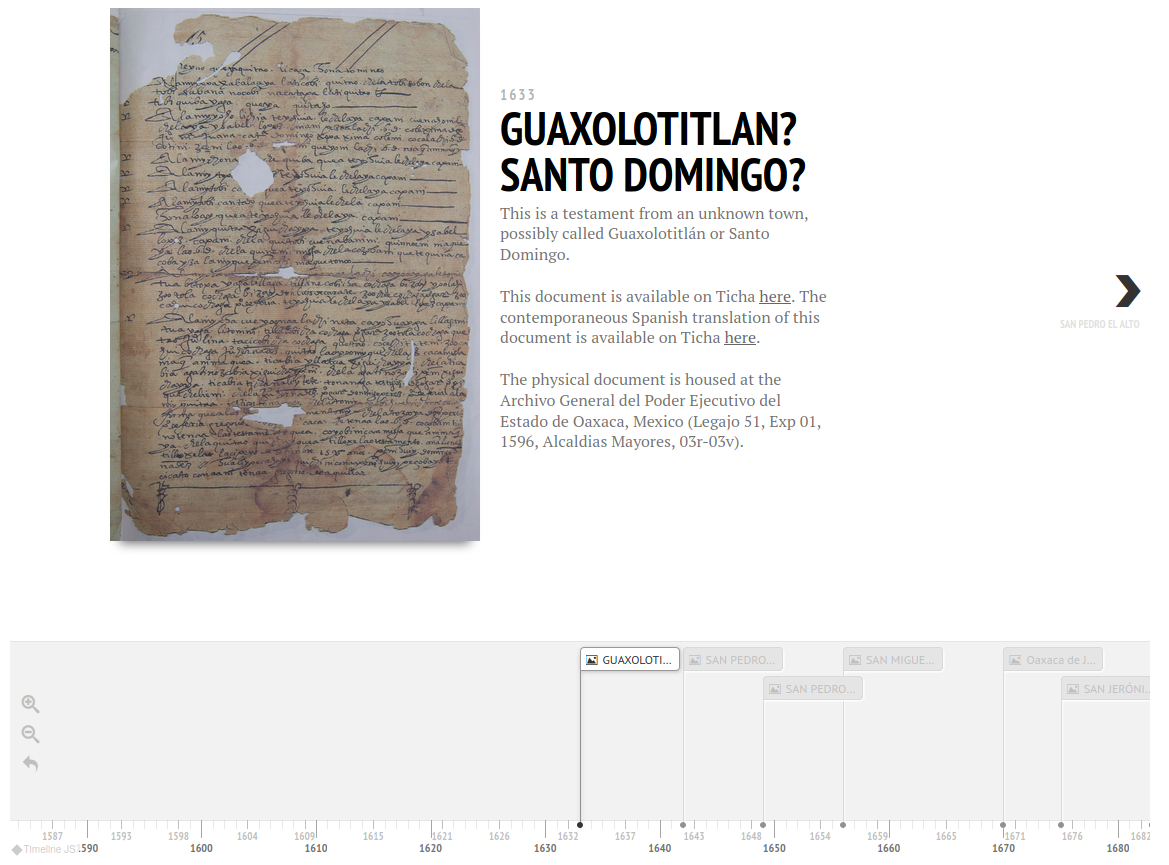
Exercise 4.1
Now, click on Explore then Place. This map of manuscripts shows a blue marker on each town where documents were written. Once you choose a town, clicking the Manuscripts link in the pop-up will take you to a new page with a list of documents.
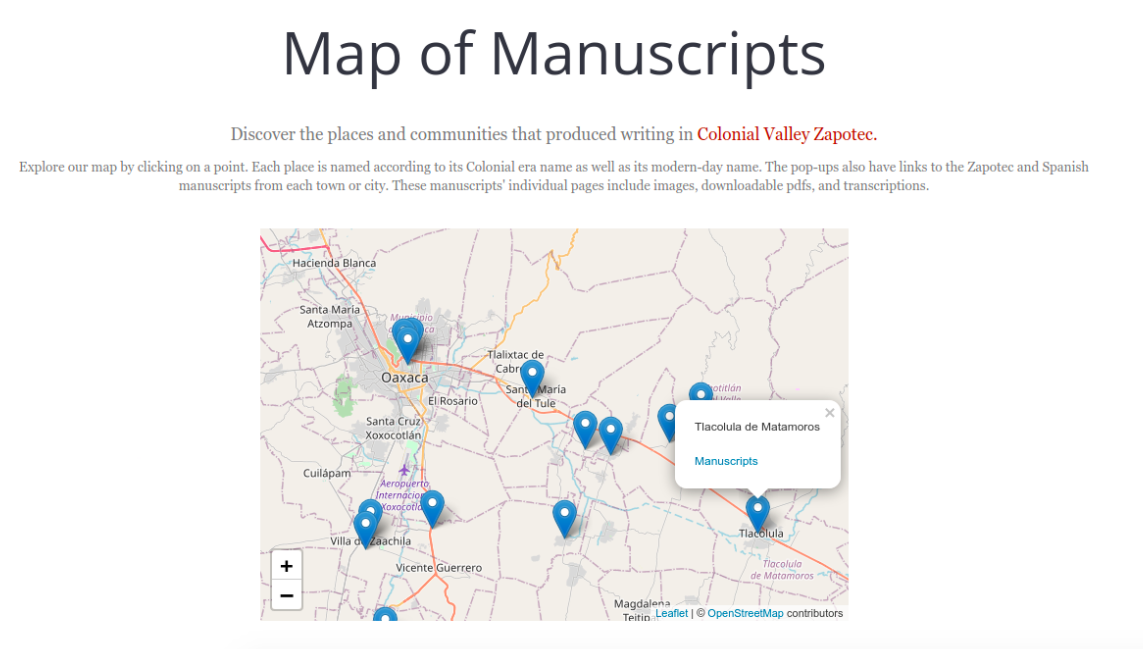
Exercise 4.2
A third way to navigate the documents is by clicking Texts then clicking Manuscripts. This brings up a long list of all of the documents.

This list has some of the same metadata fields as we saw on the first manuscript page we looked at, including the archive and the town. You can click on a heading to sort by that field, or click on a label (a specific archive, for example) to see only documents that have that label. You can also search for a particular place or type of document. In Figure 8, I’ve searched for “Receipt” so I see only documents which are labeled as receipts under Type of Document.
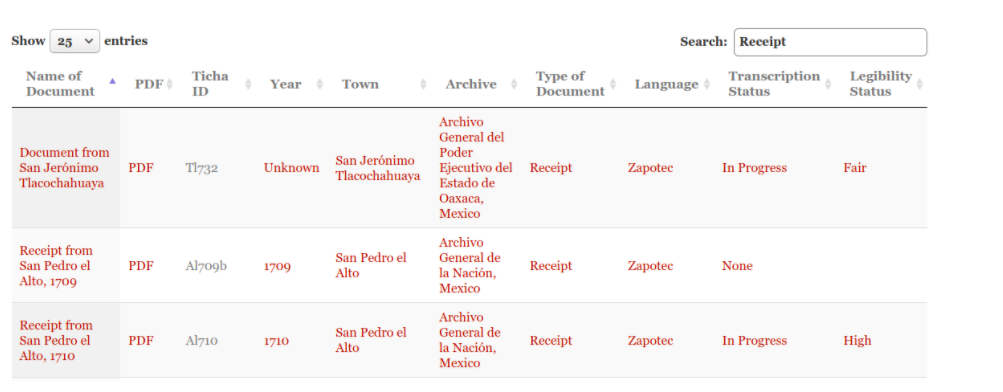
5. Explore Cordova’s Arte
So far, we’ve been looking at legal documents that were written in Zapotec towns. These handwritten documents were created by Zapotec speakers and written down by a local scribe. But there are also books that were written in or about Zapotec and printed by the Catholic church. One of these books was a grammar of Colonial Valley Zapotec published by a Spanish friar, Juan de Cordova. The grammar is called Arte en lengua zapoteca. It was likely written with the help of many Zapotec people, but they are not credited.
The Arte is very long, so it’s helpful to start by choosing a single section to look at. To start looking at the Arte, use the navigation bar and click on Texts, then Cordova, Arte, then Outline.
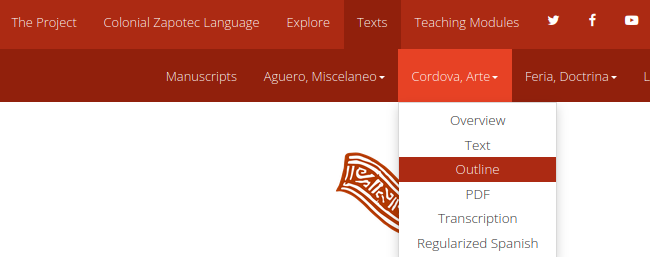
Using the outline, you can choose a specific part of Zapotec grammar you might be interested in. Cordova organized the grammar like a Latin grammar, because that’s how he was trained to think about language. Zapotec grammar is very different from Latin grammar, so sometimes it can be hard to tell what Cordova is talking about. For example, section 2.2 of the Arte is about the “declension” of nouns, which is something that happens in Latin but not in Zapotec.
As an example, we’ll look at Cordova’s section on diminutives (section 2.3.6). Diminutives are ways of indicating that something is very small, like the -ito in the Spanish word gatito ‘little cat’. Clicking the link “2.3.6. Nombres diminutivos” in the outline will take us to the page of the Arte where Cordova talks about diminutives in Colonial Valley Zapotec.
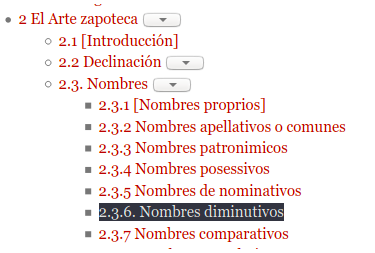
Similar to the document pages we looked at earlier, this page of the Arte is divided into an image of the original book on the left and a transcription of the text on the right (see Figure 11). The Arte is written in Early Modern Spanish, which may be challenging to read; you can click on the “Modern Spanish” tab to see a modernized version of the text.
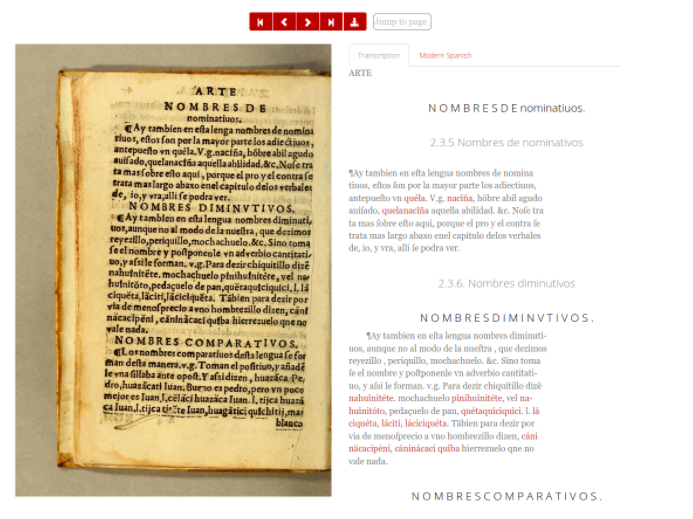
Zapotec words in the Arte are printed in red in the transcription. If you click on a word, you can see a translation of the word from the Ticha team. This can help you understand more details about the Zapotec words that Cordova doesn’t explain (see Figure 12).
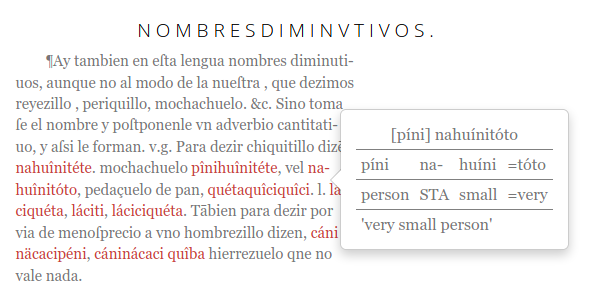
Exercise 5.1 How does it work in your language?
Exercise 5.2
Exercise 5.3
Exercise 5.4
Exercise 5.5
Do you want to expand and improve the resources on Ticha? You can help us by transcribing documents! Click on the Transcribe button on a document page to try transcribing that page. For more information, watch this short video with Dr. Brook Danielle Lillehaugen. (The video is in Spanish; you can turn on English subtitles by clicking CC in the bottom right.)
6. Beyond Ticha
Two Colonial Valley Zapotec wills have been published in the journal Tlalocan. These publications describe the historical context of the document and provide a detailed translation.
- Munro, Pamela, Kevin Terraciano, Michael Galant, Brook Danielle Lillehaugen, Aaron Huey Sonnenschein, Xóchitl Flores-Marcial, Maria Ornelas, and Lisa Sousa. 2018. The Zapotec language testament of Sebastiana de Mendoza, c. 1675. Tlalocan XXIII, pp. 187–211. https://revistas-filologicas.unam.mx/tlalocan/index.php/tl/article/view/480/458.
This publication is about the will of Sebastiana de Mendoza, a woman from San Jerónimo Tlacochahuaya. This publication is in English. You can look at images of the original will here: https://ticha.haverford.edu/en/texts/Tl675b/.
- Munro, Pamela, Kevin Terraciano, Michael Galant, Xóchitl M. Flores Marcial, Aaron Huey Sonnenschein, Brook Danielle Lillehaugen, and Diana Schwartz. 2017. Un testamento zapoteco del Valle de Oaxaca, 1614. Tlalocan XXII, pp. 15–43. https://revistas-filologicas.unam.mx/tlalocan/index.php/tl/article/view/468/446.
This publication is about the will of Sebastián López, a man from San Sebastián Teitipac. This publication is in Spanish.
Exercise 6.1
When linguists translate documents, they use multiple types of translation to convey as much information as possible about the original language. The translations in these publications have four lines. Look at the example below, which comes from the will of Sebastiana de Mendoza (line 11). Line 1 is a plain transcription. In Line 2, the transcription is broken up word by word, with some words further separated into parts. In Line 3, each part is translated separately. For example, the word xtenia can be broken into xteni, which means ‘of’ and a, which indicates a first person singular (like ‘I’ or ‘me’). Together, these make a possessive construction, which in English would be said my or of mine. In Line 4, the line is translated with a normal English sentence.
- anima xtenia rigo ya lachiña Bexuanana Dios
- anima xteni=a ri-go=ya lachi-ña Bexuana=na Dios
- soul of=1S HAB-put=1S heart-hand lord=1P God[1]
- I put my soul in the hands of our lord God
Line 3 is called a “morphological translation” or “morphological analysis”. (Morphology is the study of parts of words.) Line 4 is called a “free translation”. The free translation is easier to read, but the morphological analysis gives us more details about the original language, as there are significant differences in word order and vocabulary between Colonial Valley Zapotec and English. The morphological analysis may contain abbreviations of technical linguistic terms, as it does here.
This kind of analysis in general is known as an ‘interlinear analysis. There is an entire chapter later in the book dedicated to exploring interlinear analyses, should you want to learn more about them.
Even if there are footnotes explaining the abbreviations, the terminology may still need further explanation — for example, you may wonder what “habitual” (HAB) means? Unfortunately, these publications may not explain all the linguistic terminology. Don’t let that discourage you from trying to understand the text!
Exercise 6.2
Exercise 6.3 How does it work in your language?
As you read one of the wills, compare the Colonial Valley Zapotec transcription with the translation provided by the article’s authors. How would you say this in your language? How is Colonial Valley Zapotec different from the Zapotec language you speak?
- Abbreviations: 1S=first person singular; 1P=first person plural; HAB=habitual. ↵
There are many ways to write language! English and Spanish are written with a phonetic writing system, where each letter represents a sound. In a logographic writing system on the other hand, each symbol represents a meaning (a word or a part of a word). A common example of logographic writing is the Chinese writing system (hanzi). Pre-colonial Zapotec writing used a system with some logographs (representing words) and some phonetic symbols (representing sounds).
We use metadata ("data about data") to describe objects and information stored in archives. When describing a written document, the metadata might include the year the document was written, the language it was written in, where in the archive the document is stored, and even the type of paper it was written on!
When we talk about archival documents, a manuscript is any document written by hand, as opposed to a printed document made using a printing press or an electronic printing machine.